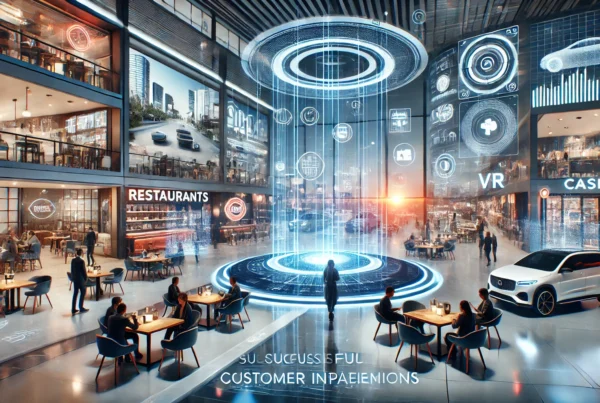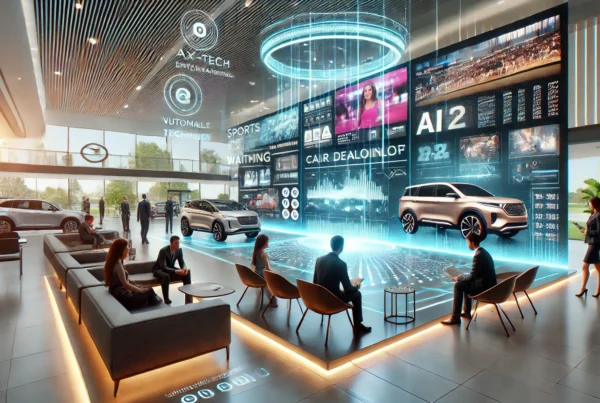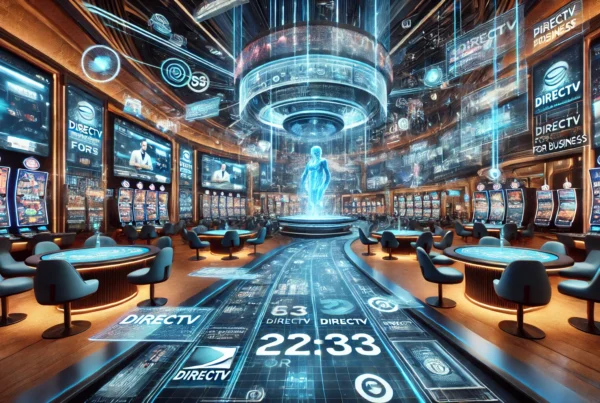In today’s fast-paced digital landscape, the ability to leverage technology for enhanced customer engagement is not just a competitive advantage—it’s a necessity. As businesses strive to meet evolving customer expectations, technology serves as a powerful tool to create personalized, efficient, and memorable interactions. Whether you’re in the hospitality, gaming, or automotive industry, understanding how to effectively use technology can transform customer experiences and drive loyalty.
Imagine walking into a bustling restaurant where your favorite dish is recommended before you’ve even glanced at the menu, or receiving personalized offers from your local car dealership just when you’re considering an upgrade. These are just glimpses of what’s possible when businesses harness the power of technology to enhance customer engagement. By integrating tools like AI-driven analytics and automated communication systems, companies can anticipate customer needs and deliver tailored experiences that resonate.
At Sports Direct, we understand the vital role technology plays in not only meeting but exceeding customer expectations. Our mission is to empower businesses across various sectors to utilize cutting-edge video programming solutions, enhancing their on-premise entertainment and engagement strategies. As we explore the innovative ways technology is reshaping customer interactions, we’ll uncover the tools and techniques that can elevate visitor satisfaction and foster lasting connections.
Ready to dive deeper into the world of technology-driven customer engagement? Join us as we explore the transformative potential of these advancements and how they can be effectively implemented to boost your business’s customer engagement strategies in 2025 and beyond.
Understanding the Role of Technology in Customer Engagement
In the rapidly evolving digital landscape, technology has become a cornerstone for businesses aiming to enhance customer engagement. By leveraging tools such as artificial intelligence (AI), data analytics, and automation, companies can transform customer experiences to meet the ever-changing expectations of their clientele. As highlighted by competitors like Inspiro, these technologies are pivotal in delivering personalized and efficient customer interactions.
For businesses in the hospitality, gaming, and automotive industries, understanding the role of technology in customer engagement is crucial. By integrating advanced solutions, these industries can not only improve customer satisfaction but also build lasting relationships. Let’s delve into how technology is reshaping customer engagement strategies and explore the benefits and challenges that come with it.
The Impact of AI and Automation on Customer Engagement
Artificial intelligence and automation are revolutionizing how businesses interact with their customers. AI-driven chatbots, for instance, provide real-time support and personalized recommendations, enhancing the overall customer experience. Automation streamlines processes, allowing companies to respond swiftly to customer inquiries and reduce wait times.
However, implementing these technologies is not without challenges. Businesses must ensure that AI tools are well-integrated into their existing systems to avoid disruptions. Additionally, maintaining a balance between automation and human touch is essential to prevent what some experts call “engineered insincerity,” where interactions feel robotic rather than genuine.
Data Analytics: Driving Personalized Customer Experiences
Data analytics plays a significant role in understanding customer behavior and preferences. By analyzing customer data, businesses can tailor their offerings to meet individual needs, thereby enhancing engagement. For example, restaurants can use data analytics to recommend dishes based on a customer’s previous orders or preferences.
Despite its advantages, data analytics requires careful handling of customer information to ensure privacy and compliance with regulations. Companies must invest in robust data security measures to protect customer data and maintain trust.
Case Studies: Successful Integration of Technology
Several businesses have successfully integrated technology into their customer engagement strategies. For instance, a leading car dealership implemented a CRM system that tracks customer interactions and preferences, enabling personalized marketing campaigns. This approach not only increased customer satisfaction but also boosted sales.
Another example is a casino that utilized virtual reality (VR) technology to offer immersive gaming experiences. By providing a unique and engaging environment, the casino attracted more visitors and enhanced customer loyalty.
These case studies illustrate the transformative potential of technology in customer engagement. By adopting innovative solutions, businesses can stay ahead of the competition and foster stronger connections with their customers.
Innovative Tools for Enhancing Customer Engagement
As we approach 2025, businesses are increasingly looking to leverage technology for enhanced customer engagement. The rapid evolution of digital tools offers unprecedented opportunities to connect with customers in meaningful ways. From CRM systems to virtual and augmented reality, these technologies are reshaping how companies interact with their clientele, providing personalized and immersive experiences that drive loyalty and satisfaction.
In this section, we’ll explore some of the most innovative tools available today and how they can be applied across various industries. Whether you’re in hospitality, gaming, or the automotive sector, understanding and implementing these tools can significantly enhance your customer engagement strategies.
CRM Systems: Building Stronger Relationships
Customer Relationship Management (CRM) systems are essential for businesses looking to understand and engage with their customers effectively. These systems allow companies to track interactions, preferences, and feedback, enabling personalized communication and service delivery. For example, a car dealership could use CRM data to send targeted promotions to customers based on their previous purchases or service history, fostering a more personalized experience.
In the hospitality industry, CRM systems can help manage reservations, track guest preferences, and deliver customized offers. This not only improves customer satisfaction but also encourages repeat visits and word-of-mouth referrals.
Virtual and Augmented Reality: Immersive Experiences
Virtual Reality (VR) and Augmented Reality (AR) technologies are revolutionizing customer engagement by offering immersive experiences that were previously unimaginable. In the gaming industry, casinos are using VR to create virtual environments where players can enjoy games in a lifelike setting, enhancing the thrill and engagement of the experience.
Similarly, in the automotive industry, AR can be used to provide virtual tours of vehicles, allowing customers to explore features and options without visiting a showroom. This technology not only enhances the buying experience but also helps customers make informed decisions.
Marketing Automation Software: Streamlining Communication
Marketing automation software plays a crucial role in delivering personalized content and messages at scale. By analyzing customer data and behaviors, these tools can automate email campaigns, social media posts, and other communications, ensuring that customers receive relevant and timely information.
For instance, a restaurant could use marketing automation to send personalized dining offers based on a customer’s dining history and preferences. This approach not only increases engagement but also drives customer loyalty and repeat business.
To help businesses evaluate these tools, the following table compares key features and benefits:
| Tool | Key Features | Industry Applications |
|---|---|---|
| CRM Systems | Customer data management, personalized communication | Hospitality, Automotive |
| VR/AR | Immersive experiences, virtual tours | Gaming, Automotive |
| Marketing Automation | Automated campaigns, data-driven insights | Restaurants, Retail |
By integrating these innovative tools, businesses can not only meet but exceed customer expectations, creating memorable and engaging experiences that foster loyalty and drive growth.
Strategies for Implementing Technology in Customer Engagement
In the pursuit of leveraging technology for enhanced customer engagement, businesses must adopt a strategic approach to ensure that the technologies they implement align with their overarching goals. As highlighted by industry leaders like Grassroots IT, the key to success lies in carefully evaluating and selecting the right technologies that can genuinely enhance customer interactions. This section will explore actionable strategies for integrating technology into customer engagement efforts, providing a roadmap for businesses to follow.
To effectively implement technology, businesses need to focus on aligning their technological investments with their customer engagement objectives. This involves understanding the customer journey, identifying pain points, and selecting technologies that can address these challenges while enhancing the overall customer experience.
Evaluating and Selecting the Right Technologies
Choosing the right technology is crucial for successful customer engagement. Businesses should start by conducting a thorough evaluation of their current processes and customer interactions. This evaluation helps identify areas where technology can make a significant impact, such as streamlining operations or enhancing customer touchpoints.
Once potential areas for improvement are identified, businesses should research and compare various technology solutions. Consider factors such as scalability, integration capabilities, and cost-effectiveness. Engaging key stakeholders, including employees and customers, in the evaluation process ensures that the selected technologies meet the needs of all parties involved.
Integrating Technology into Customer Engagement Strategies
Integration is a critical step in leveraging technology for customer engagement. Businesses must ensure that new technologies seamlessly integrate with existing systems and processes. This integration allows for a smooth transition and minimizes disruptions to daily operations.
Providing comprehensive training and support for employees is essential to maximize the benefits of new technologies. Employees should be well-versed in using these tools to enhance customer interactions, ensuring that the technology contributes positively to the customer experience.
Actionable Steps for Technology Implementation
Implementing technology in customer engagement strategies can be streamlined by following a structured approach. Here is a checklist to guide businesses through the process:
- Identify Customer Pain Points: Pinpoint areas where technology can address customer challenges and improve engagement.
- Research and Compare Solutions: Evaluate different technology options based on features, costs, and user reviews.
- Consider Scalability and Integration: Choose technologies that can grow with your business and integrate with existing systems.
- Engage Key Stakeholders: Involve employees and customers in the evaluation process to ensure the chosen technologies meet their needs.
- Provide Training and Support: Offer comprehensive training to employees to ensure proficiency with new technologies.
By following these steps, businesses can effectively integrate technology into their customer engagement strategies, ultimately enhancing customer satisfaction and loyalty. For more insights on technology-driven customer engagement, explore additional resources on Sports Direct.
Harnessing Technology for Future Customer Engagement
As we look toward 2025, the potential to leverage technology for enhanced customer engagement remains unparalleled. Businesses across sectors are already witnessing the transformative power of integrating advanced tools like AI, data analytics, and CRM systems into their strategies. These technologies not only streamline operations but also allow for a deeper understanding of customer behavior, leading to personalized and meaningful interactions.
Throughout this blog post, we’ve explored the various ways technology is reshaping customer engagement. From AI-driven chatbots that provide real-time support to CRM systems that foster personalized communication, the opportunities are vast. However, the challenge lies in selecting the right tools and ensuring they align with your business objectives. A strategic approach is crucial, as highlighted by industry leaders, to avoid pitfalls like “engineered insincerity”—where interactions become robotic rather than genuine.
Key Takeaways
- AI and Automation: These tools enhance customer service by providing real-time, personalized support, improving overall satisfaction.
- Data Analytics: Leverage customer data to tailor experiences, ensuring privacy and compliance to maintain trust.
- CRM Systems: Essential for managing customer relationships and delivering personalized communication across various industries.
- Virtual and Augmented Reality: Offer immersive experiences that engage customers in unique ways, especially in the gaming and automotive sectors.
Implementing these technologies requires careful planning and execution. Businesses must evaluate their current customer engagement strategies, identify areas for improvement, and select technologies that enhance the customer journey. Engaging stakeholders and providing adequate training ensures employees are equipped to maximize these tools’ benefits.
Now is the time to embrace these advancements and stay ahead of the competition. Explore more on how to integrate these technologies effectively by visiting Sports Direct. Dive into our resources and discover how you can transform your customer engagement strategies for the future. We invite you to join the conversation in the comments below and share your insights or questions.








